China's hidden century: illuminating the lives of individuals - Part One
Between 1796 and 1912 Qing China endured numerous civil uprisings and foreign wars, with revolution ultimately bringing an end to some 2,000 years of dynastic rule and giving way to a modern Chinese republic. This period of violence and turmoil was also one of extraordinary creativity, driven by political, cultural and technological change. In the shadow of these events lie stories of remarkable individuals – at court, in armies, in booming cosmopolitan cities and on the global stage.2
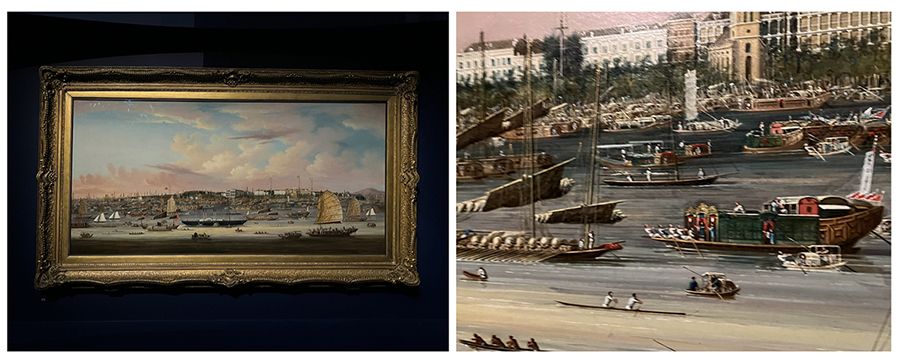
The exhibition is underpinned by a four-year research project supported by the Arts and Humanities Research Council, and led by the British Museum and London University, in collaboration with over 100 scholars from 14 countries.2
Exquisite objects were brought together for the first time – from cloisonné vases given by the Last Emperor's court to King George and Queen Mary for their coronation in 1911, to a silk robe commissioned by the Empress Dowager Cixi. The show illuminated the lives of individuals – an empress, a dancer, a soldier, an artist, a housewife, a merchant and a diplomat.2
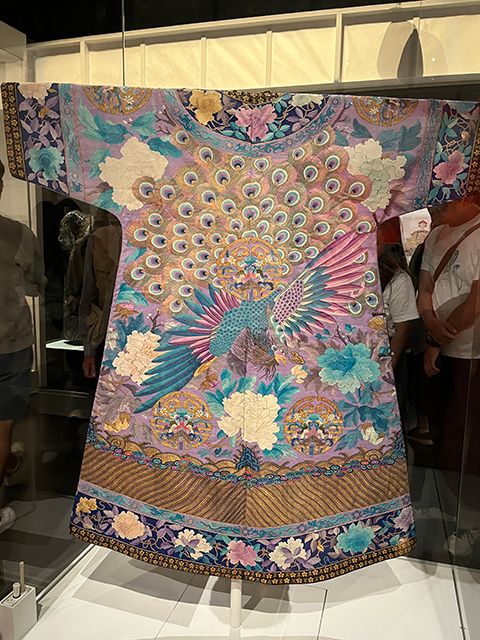
The Empress Dowager Cixi (1835-1908) was the de-facto ruler of China from 1861 to 1908. She was a consort of the Xianfeng emperor. Her son became the Tongzhi emperor, and her nephew ruled as the Guangxu emperor. She was a direct contemporary of Queen Victoria, whose life fascinated her. Cixi's reputation suffered in China after she effectively deposed her nephew. After this, she was increasingly seen as a power-hungry old woman.1
Made for the Empress Dowager, this informal outer gown incorporates Japanese Meiji-period (1868-1912) motifs from contemporary kimono designs, including a swooping phoenix with peacock tail feathers. Cixi had hundreds of sasual robes and changed her costume about 10 times daily. 1
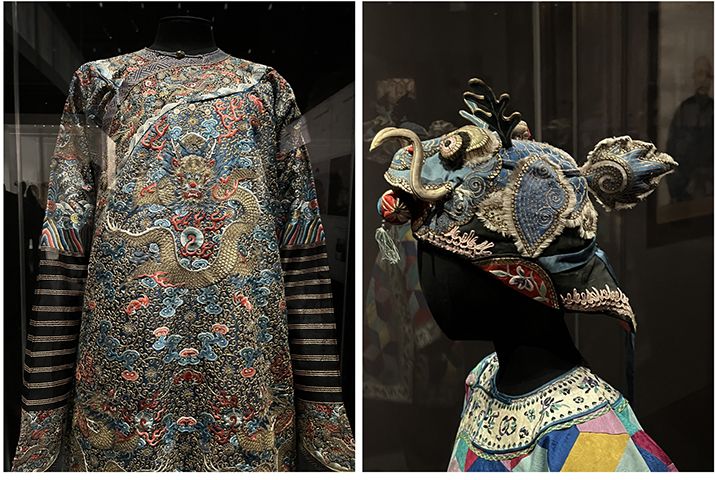
Emperors were believed to control the universe. This full-length garment (above left) is decorated with nine gold dragons (one is hidden under the innerfront fold). The multicoloured auspicious clouds indicate that a sage ruler is on the throne. The emperor’s robe is further distinguished by 12 imperial symbols: sun, moon, constellations, mountains, paired dragons, a pheasant, ritual cups (with tigers), water weed, millet, fire, an axe and a fu symbol.1
The very short video below focuses on the visual details of this exquisite robe.
Below are examples of the military uniforms of the period.
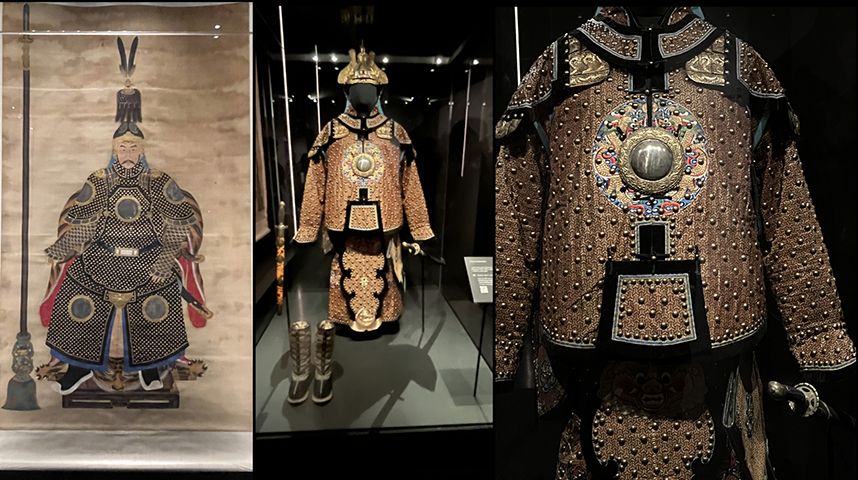
If you have time and are interested in textile work please watch the video below from the British Museum.
Visitors glimpsed the textures of life in 19th-century China through art, fashion, newspapers, furniture – even soup ingredients. Many people not only survived but thrived in this tumultuous world. New art forms, such as photography and lithographic printing, flourished while technology and transport – the telegraph, electricity, railways – transformed society.2
For me as an outsider viewing this exhibition, one of the most amazing items was this "image" of a middle class Chinese man in the C19th.
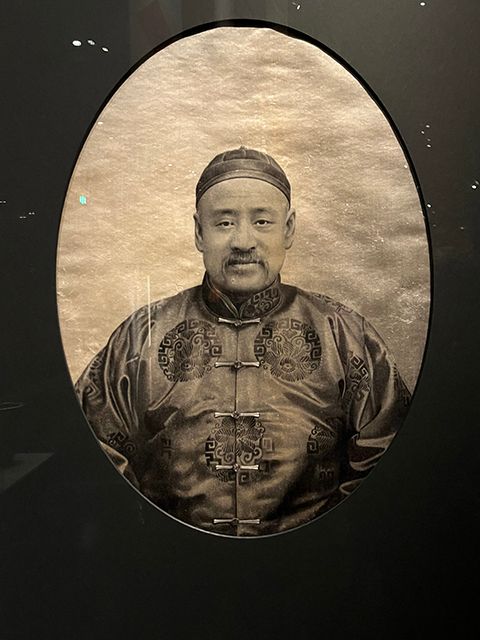
This portrait of a middle-class man is entirely stitched, but copies a photograph precisely. During the 1870s, sitting for photographic portraits was a preserve of the rich but by the close of the Qing dynasty in 1912 more of the population could afford to be recorded in this way. Stitched portraits are rare and were expensive to purchase, a piece like this took many months to complete by hand. 1
Below are close-up photos to show you the details in the image.
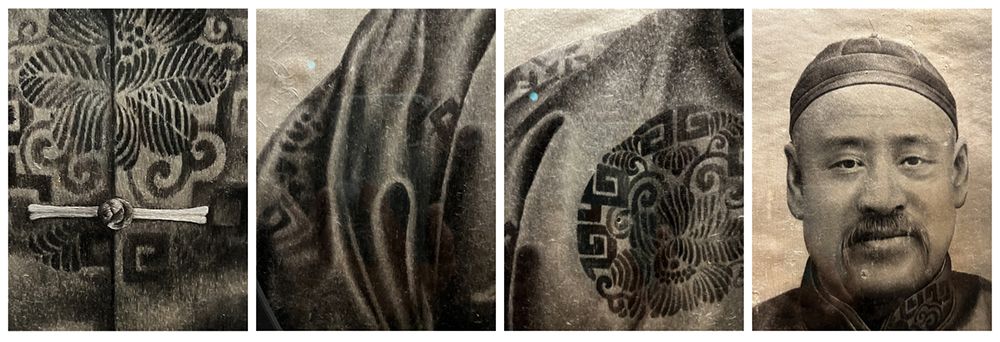
The above examples are obviously from the wealthy few who enjoyed a prosperous and productive life. But...
Rapid population growth put enormous pressure on the land, leading to environmental disasters, land shortages and rural poverty. Expansion of the Han along the edges of the Qing empire into areas previously inhabited only by non-Han peoples sometimes drove tension as people competed for their livelihoods. Extreme weather aggravated the economic crisis. the Great Northern Famine of 1876 to 1879, which followed a three-year drought, claimed at least 9.5 million lives. 1
But the ingenuity of these rural people who relied on the land and what could be grown for survival must never go unnoticed...

Rural fishermen and farmers had worn this type of waterproof raincoat and hat for centuries. In urban settings, poorer people including porters, street cleaners and labourers also wore such garments as protection from the elements. Regional variations existed, depending on which plants were available locally. In the far south palm leaves or cocnut fibres were used instead of rice or millet. This coat was made by folding layers of straw or leaves, then stitching them to the layer above using rice-straw thread. 1
This extraordinary exhibition opened a new page in public understanding of late imperial China.
Tomorrow I will showcase more examples from the China's Hidden Century Exhibition.
Credits
1. Exhibition labels - britishmuseum.org
2. britishmuseum.org
